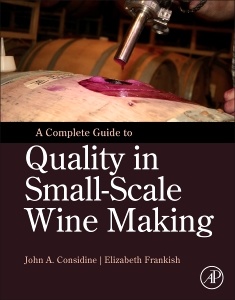Description
A Complete Guide to Quality in Small-Scale Wine Making
Authors: Considine John Anthony, Frankish Elizabeth
Language: English
Subject for A Complete Guide to Quality in Small-Scale Wine Making:
Keywords
wine chemistry; safety; fermentation; berry maturity; pH; aroma tests; wine production
Publication date: 10-2018
224 p. · 21.4x27.6 cm · Paperback
Replaced by new edition: Access to the new edition.
Publication date: 01-2014
224 p. · 21.5x27.6 cm · Hardback
Replaced by new edition: Access to the new edition.
Description
/li>Contents
/li>Readership
/li>Biography
/li>Comment
/li>
As the wine industry has experienced a period of rapid global expansion, there is a renewed emphasis on quality and consistency even within the small winery industry. Written for the small production program, A Complete Guide to Quality in Small-Scale Wine Making is for the novice to intermediate level winemaker seeking foundational information in chemistry and sensory science as they relate to wine quality at a technical level.
Drawing from personal experience as well as scientific literature, this book introduces the core concepts of winemaking before delving into methods and analysis to provide practical insights into creating and maintaining quality in the wine product.
1. Introduction to the Table Winemaking Process2. Flavours and aromas in foods and beverages3. Wine Chemistry4. Safety5. Table wine production6. Microbiology & Methods7. Harvest Protocols8. Winery Protocols9. Principals of analysis10. Essential analyses11. Quality assurance, teaching and research12. Sample statistics
Those launching or involved with small winery production.
Introductory level winemaking courses whether in an academic or a technical setting. Such a course would normally be taken by both winemaking and viticultural students. It would also suit adult education
Elizabeth Frankish is a food safety consultant with extensive experience in diagnostic microbiology and risk management for the food industry, including the horticulture, seafood, dairy, and meat sectors. With qualifications in agricultural science and experience in business and project management, she has delivered practical solutions to companies large and small to meet the challenges of microbial contamination, product development, monitoring programs, and training needs from a holistic perspective. She has helped develop numerous food safety guidelines for horticulture and continues to pursue her passion for prevention of food safety incidents through better understanding of the interactions between food systems and their microbial flora.
- Understand the chemistry and sensory science at the foundation of quality wines
- Explore real-world examples of key analysis and application of concepts
- Practice methods and exercises for hands-on experience
These books may interest you

Wine Production and Quality 86.95 €

Production Wine Analysis 105.49 €

WinemakingBasics and Applied Aspects 250.90 €

